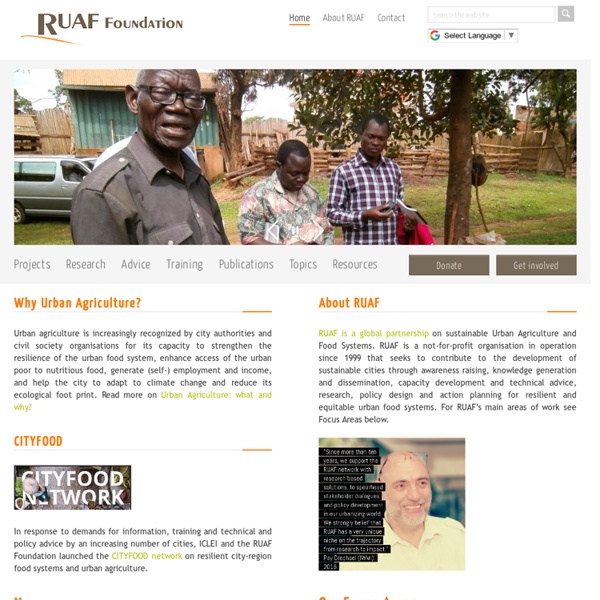



Free lectures on permaculture (Permaculture Media Blog) Free lectures on permaculture (Permaculture Media Blog) Read at : Introduction to Permaculture – 40 hours of Free video lectures This course will explore, through lectures, discussions, field trips, and required projects, a design/thinking methodology that seeks to profide for our physical needs, food, water, shelter, energy, etc., while doing so in an environmentally friendly, sustainable manner. (continued) Like this: Like Loading... About Willem Van Cotthem Honorary Professor of Botany, University of Ghent (Belgium).
the Economics of Happiness | Home Círculos de Estudio / FrontPage El wiki de Círculos de Estudio Estamos trasladando y ampliando este wiki! ver www.PermaCultureScience.org esta web fue un gran proyecto piloto y estamos ahora desarrollando un gran Manual de Permacultura Integral como libro-e gratis, en la web sigue el sol .. www.PermaCultureScience.org pincha arriba a la izquierda para volver a esta página de inicio con el mapa de los sitios Ver programas y cursos aquí (en continuo desarrollo) Hola Bienvenid@ Por favor, ten en cuenta que este wiki está en construcción. Será una tarea de (posiblemente) varios años poner aquí todos los materiales de estudio que queremos. Algunos de los actuales no son lo ideal, pero los ponemos por ahora mientras vamos poco a poco digitalizando y colgando el tesoro que compartimos en los cursos. ¡Gracias por tu paciencia! Hay una gran variedad de Programas de CURSOS donde usar estos materiales, elige la que mejor se te adapte.
Permacultura - Academia NodoEspiral LifeWeb:Book - EARTHDANCE: Living Systems in Evolution Dancing is surely the most basic and relevant of all forms of expression. Nothing else can so effectively give outward form to an inner experience. Poetry and music exist in time. LifeWeb: The Writings of Elisabet Sahtouris After Darwin - Reuniting Spirituality with Science in Order to Form a New World View, (new - 8/03)HTML, PDF, ASCII text formats Vistas - Evolving Our Beliefs to Evolve Our Lives (new - 2/04)HTML, PDF, ASCII text formats Discovering the Living Universe - Scientific Spirituality for a Global Family (new - 12/03)HTML, PDF, ASCII text formats A Tentative Model for a Living UniversePart OnePart Two Skills for the Age of Sustainability: An Unprecedented Time of Opportunity HTML, PDF, ASCII text formats Issues of Human Evolution into Global Community (2/02)HTML, PDF, ASCII text formats What's Wrong with Environmental Education? Lightening Up for the New Millenium (2/02)HTML format, ASCII text What Our Human Genome Tells Us (6/01)HTML format, ASCII text Living Systems, the Internet and the Human Future (11/00)HTML, PDF, gzip'd PostScript ASCII text, formats Living Systems in Evolution (5/00)HTML format, ASCII text The Evolving Story of our Evolving Earth (11/99)HTML format, ASCII text
What We Learned in the Rainforest: Business Lessons from Nature : Innovation ... - Tachi Kiuchi, William K. Shireman Future 500: What We Learned in the Rainforest - Business Lessons ...In What We Learned in the Rainforest - Business Lessons from Nature, we tell the story of how companies create value, using the same principles that drive ...www.future500.org/books ReferencesREVIEWS. 266. Journal of Industrial Ecology. to improve social outcomes), it is doubtful that. this addition to knowledge is yet, or ever will be, ...www.mitpressjournals.org/doi/pdf/10.1162/108819804323224861 Plus donatenowWhat We Learned in the Rainforest: Business Lessons from Nature Written by Future 500 Chairman and President, Tachi Kiuchi & Bill Shireman, "What We Learned ...secure.groundspring.org/dn/index.php?aid=5805 What We Learned in the Rainforest: Business Lessons from Nature ...What We Learned in the Rainforest: Business Lessons from Nature (Kiuchi, Tachi; Shireman, Bill and Shireman, William K) -- Bibliography (issues) Online by ...www.diversitas.org/db/x.php? ecoiq Magazine Spring 2002 FeaturesFeature Articles:. Moins
Outlook options